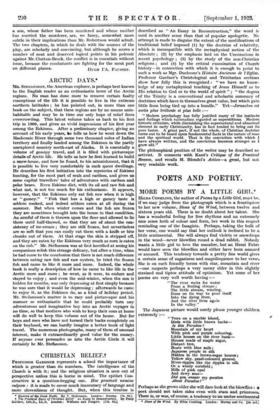ARCTIC DAYS.*
Ma. STEFANSSON, the American explorer, is perhaps best known to the English reader as an enthusiastic lover of the Arctic regions. No man has done more to remove certain faulty conceptions of the life it is possible to live in the extreme northern latitudes ; he has pointed out, in more than one book on the subject, that these regions are by no means unin- habitable and may be in time our only hope of relief from overcrowding. This latest volume takes us back to his first trip in 1906, and gives us vivid impressions of his first year among the Eskimos. After a preliminary chapter, giving an account of his early years, ke tells us how he went down the Mackenzie River through some two thousand miles of Indian territory and finally landed among the Eskimos in the partly unexplored country north-east of Alaska. It is essentially a volume of gossipy travel, and it is filled with picturesque details of Arctic life. He tells us how he first learned to build a snow-house, and how he found, to his astonishment, that it is possible to live very comfortably in such queer dwellings. He describes his first initiation into the mysteries of Eskimo hunting, for the most part of seals and caribou, and gives us some capital travellers' tales of adventures with caribou and polar bears. Even Eskimo diet, with its oil and raw fish and what not, is not too much for his enthusiasm. It appears, however, that the Eskimos only eat fish raw when it is high or "gamey." "Fish that has a high or gamey taste is seldom cooked, and indeed seldom eaten at all during the summer. But when winter comes and the fish are frozen they are sometimes brought into the house in that condition. An armful of them is thrown upon the floor and allowed to lie there until half-thawed, so that they are of about the con- sisteney of- ice-cream ; they are still frozen, but nevertheless are so soft that you can easily cut them with. a knife or bite chunks out of them. At that stage the skin is stripped off, and they arc eaten by the Eskimos very much as corn is eaten on the cob." Mr. Stefansson was at first horrified at seeing his companions relish this strange delicacy, but after a time, when he had come to the conclusion that there is not much difference between eating raw fish and raw oysters, he tried the frozen fish and came to like it more and more. Indeed, the whole book is really a description of how he came to like life in the Arctic more and more ; he went, as it were, to endure and stayed to enjoy ; and even the mid-winter, when the sun is hidden for months, was only depressing at first simply because he was sure that it would be depressing ; afterwards he came to enjoy it, as the Eskimos do, as a kind of holiday period. Mr. Stefansson's matter is so racy and picturesque and his manner so enthusiastic that he could probably turn any adventurous and imaginative boy into an Arctic voyager in no time, so that mothers who wish to keep their sons at home will do well to keep this volume out of the house. But for boys and men who have not turned their backs completely on their boyhood, we can hardly imagine a better book of light travel. The numerous photographs, many of them of unusual interest, make it extraordinarily good value for the money. If anyone ever persuades us into the Arctic Circle it will certainly be Mr. Stefansson.


































 Previous page
Previous page